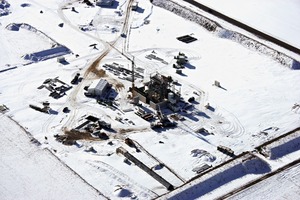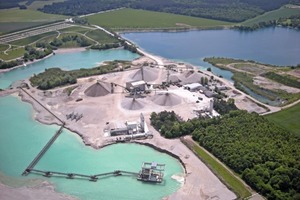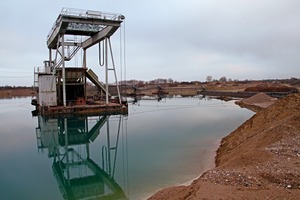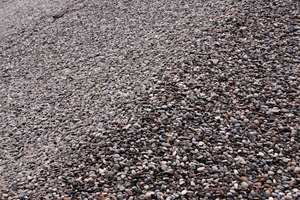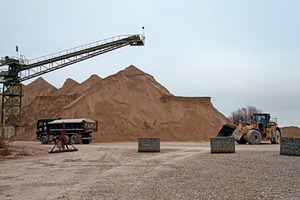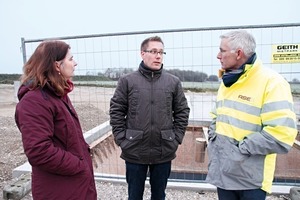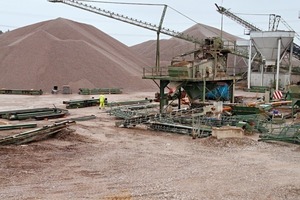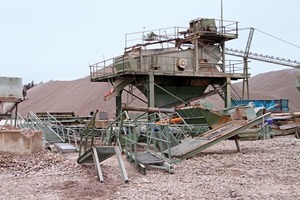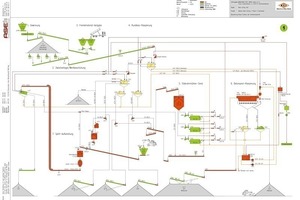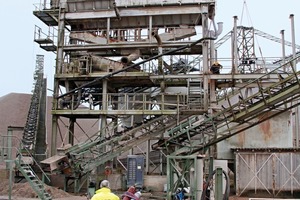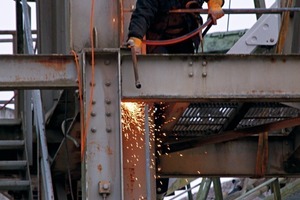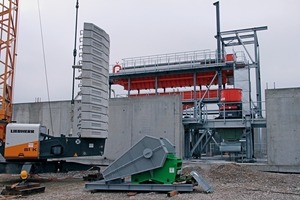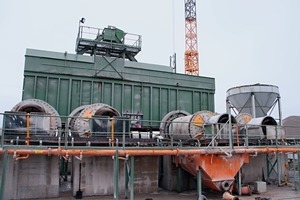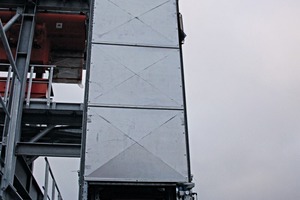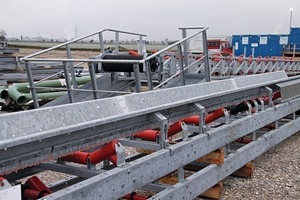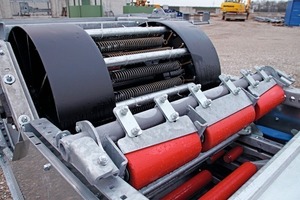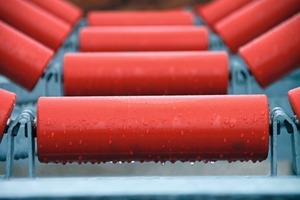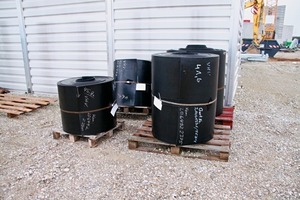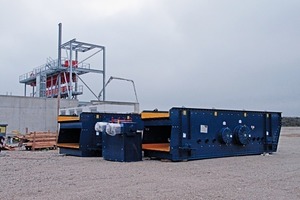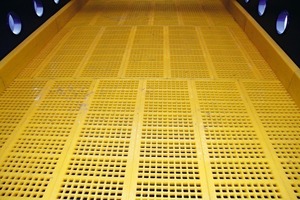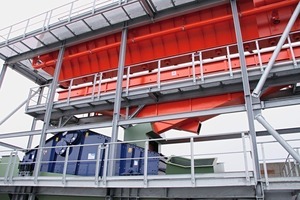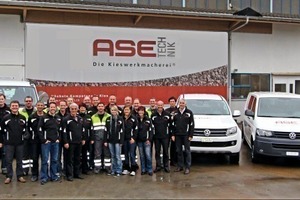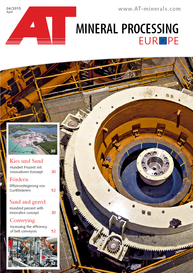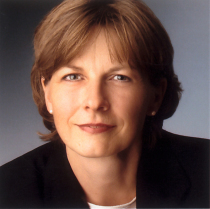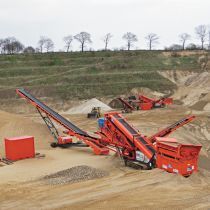Hundred percent with innovative concept
After 30 years of gravel extraction at the Hollerner See, a lake between Eching and Unterschleissheim near Munich, the deposits are now exhausted and the Münchner Kies Union (MKU) is relocating to a new site (Fig. 1 and Fig. 2). Together with ASE Technik AG, MKU is building a new gravel works around 2.5 km away in Eching Sued, which is set to go into operation in spring 2015.
MKU supplies its customers with natural sand (0-4 mm), various aggregate grades (4-8 mm, 8-16 mm, 16-32 mm), crushed sand (0-2 mm) as well as chippings (2-5 mm, 5-8 mm, etc.). Besides these standard products, MKU sells special products such as fall protection gravel, dry winter grit and mixes of sands and chippings formulated to meet customer requirements.
At the old site, MKU used a floating grab dredge with trolley and a 7-m³ hydraulic grab supplied by ROHR Bagger GmbH (Fig. 3). The raw material was transported on six floating belts and various overland belts to the raw gravel stockpile with a volume of around 30 000 t. The stockpile was used for the purpose of buffer storage between the extraction and processing operations (Fig. 4 and Fig. 5), so that the two parts of the site could be operated independently of each other. The processing plant with a capacity of maximum 450 t/h is being dismantled and to a large extent reassembled at the new site.
During the dismantling phase at the old gravel works, Dr Petra Strunk and Ulrike Mehl, editors of AT MINERAL PROCESSING, took the opportunity to visit the site and talk to Dipl.-Ing. (FH) Markus Oberholz, General Manager at MKU as the client, and Dipl.-Ing. Michel Kleisli, Managing Director and Owner of ASE Technik AG, the company responsible for the general design and planning and plant engineering (Fig. 6).
AT: Moving a gravel works is certainly a formidable challenge. What requirements had to be met?
Oberholz: It had long been decided that we should have to give up the site in 2016 at the latest owing to the depletion of raw materials at Hollerner See and then move the production site (Fig. 7). Naturally, we had earmarked a certain investment budget. It was important to us to keep the main processing steps and accordingly to take a large part of our equipment with us to the new site (Fig. 8). We also wanted to take the move as the opportunity for some modernization and optimize the production process so that we can really offer 100 % of our raw material as saleable products. And finally it was also a matter of reducing the maintenance and energy costs at the new site.
It was obvious to us that we would need support for this project. For that reason, from the year 2010 we held the first talks with various design and planning offices, including ASE Technik AG. Giving them the edge over the competition, ASE Technik submitted several well-thought-out concepts from the outset. They gave us the choice between different plant variations and set-ups. This commitment even before we had awarded the contract certainly impressed us.
AT: Did the design and planning offices have the opportunity to first look at the old and the new sites?
Oberholz: A visit to the old site was not absolutely necessary as the equipment is common in the industry. Apart from the tender documents with details of the investment budget, annual throughput, etc., we gave the design offices an extract of the development plan as a basis for their concept design – and, of course, we telephoned with each other and held meetings. In the end, ASE Technik simply presented the best design and that convinced us.
Kleisli: We have already built various gravel works in Switzerland and we invited MKU to take a look at these projects – to show them our signature work, so to speak. Ultimately we didn’t just want to do the design, ASE Technik has a team with whom we can realize the design, fabrication, assembly and commissioning. It was therefore important to us to find a client with whom we can build up good cooperative relationship, develop and also realize an overall plan.
On the basis of the documents and the specified investment budget, we began by working on different proposals on how to use the site and effectively integrate the concrete plant as well as to build as compactly and efficiently as possible. Once we had been awarded the contract, we worked closely with MKU to draw up an overall plan. That took a certain time, during which ideas were developed, rejected or accepted. At the end of this planning phase, the overall concept was derived with a defined cost structure and flow chart with plant design as a solid foundation for the conversion phase (Fig. 9).
AT: In what areas was there more or less that needed to be discussed?
Kleisli: In Switzerland, gravel plants are planned with direct feed to the concrete plants from the silos, so that everything is supplied from one source. We would have liked to have done that here at MKU. But that wasn’t possible for organizational reasons.
Oberholz: With regard to the basic idea, this concept is certainly exciting. But we have been working for many years at the Eching site with two different customers in trust-based cooperation. Both have agreed to move with their plants to the new site. Therefore we have decided to keep the traditional feed systems with the wheel loader as we have used up to now. After all, otherwise if one of the two customers wanted to shut down their concrete plant, we would have a direct connection to the silo that would then end in nothing.
Kleisli: A special aspect was certainly also that we have taken over part of the plant engineering from the old site. MKU also wanted to integrate the steel structure from the old plant (Fig. 10) in the new works. The dismantling of the old steel structure is quite a complex undertaking (Fig. 11), as every part has to be labelled to make sure it is installed in the right place at the new site. In addition, the steel components are sandblasted and re-galvanized before assembly begins at the new plant. There we can fit the equipment precisely into the steel structure and optimally design access to the machines for the work processes.
AT: What crushing system have you chosen?
Oberholz: It is standard to work with impact crushers in applications such as this. But here we sometimes process wet material, which is ultimately associated with higher wear and maintenance costs in the crushers and, for this reason, such as standard solution would have been economically unfavourable. An impact crusher is perhaps slightly cheaper in terms of investment, but leads to more rejects and in any case higher follow-on costs. After some considerations, in the end we opted for a two-stage crushing process for which the investment was somewhat higher. However, we produce less or no reject material and overall we have achieved an increase in the output. The special aspect of our new crushing concept is its integration in wet gravel processing.
The raw gravel is fed as starting material from the stockpile on a chute to the screens and from there goes into the first crushing stage for gravel 32-X in a jaw crusher supplied by Comec Binder, which is designed for 40 t/h. Upstream of that, we have integrated air drying to pre-dry the material already at the discharge. The comminuted material is then fed in the second stage together with the 16-32 gravel to the Sandvik cone crusher (Fig. 12). We use this to produce saleable sand and chippings. The oversize is then transferred into the rod mills for sand production. The rod mills are also being moved from the old gravel works (Fig. 13). These big mills cause a significant investment, but we get rounded sand particles that are very similar to natural sand.
AT: What new things will there be at the new site?
Kleisli: Once the two-stage crushing concept had been decided on, that is after the project planning phase, we started with the submission. For the crushers, for example, we work with different machine suppliers – for example, SBM, Hazemag, Comec Binder and Sandvik. We perform a technical and commercial assessment so that the client – in this case, MKU – sees the advantages and disadvantages of the respective equipment combination and can decide freely what he wants to buy in the end.
The double-belt conveyor will be reinstalled as a vertical conveyor with 11.5 m elevation (Fig. 14). Basically, we aren’t tied to any one supplier, but we are sourcing the conveying systems from VHV Anlagenbau (Fig. 15). With the double belt, the material is held as if it were in a pocket, i.e. the top and bottom belts enclose the material so that it cannot escape at the sides.
Oberholz: In the old plant we had a bucket elevator, which had always caused us problems and in the last few years needed repairs more and more frequently. When we went to Switzerland to inspect the reference projects, the double-belt conveyor from VHV convinced us (Fig. 16 and Fig. 17). The bucket conveyor is cheaper, but you then need all the peripheral equipment, i.e. feed and discharge belt, wear-intensive transfer points, etc. And access to the conveyor is difficult when repairs have to be done.
With the vertical conveyor we get everything in one: motor, gears, feed-in, discharge. There is no material loss and the operating and maintenance costs are reduced (Fig. 18).
AT: You’re getting funding from Germany’s Federal Ministry of the Environment for the rebuilding of your plant. What innovative measures were the reason for this?
Oberholz: Usually, two self-sufficient process lines are operated. There is the dry crushing process and wet round gravel processing. As already mentioned previously, in future we shall combine the two processes by integrating the dry crushing operation with the jaw and cone crushers in the wet round gravel processing. In this way, previously unused raw gravel larger than 32 mm and reject sizes can be pre-crushed. Following the subsequent screening of sand and chippings, the reject material, i.e. oversize, is sent to the rod mills for sand production.
Kleisli: This innovative concept also includes the entire process water being sent to a hydrocyclone plant. This gives us the possibility to recover very fine sand. We chose the Akorel free-fall classifier from AKW Apparate + Verfahren GmbH as this has the advantage of guaranteeing a constant concrete sand.
Oberholz: With this concept of material processing and recovery for the production process, we shall in future be able to process 100 % of our raw material to saleable products and offer, in addition to the standard products, sand and chippings in different grades to meet specific customer requirements. We expect less wear, we will require less energy and we will reduce the dust exposure. For this reason, we made an application for funding, which was then granted.
AT: Will you be able to meet your schedule?
Oberholz: The actual challenge is relocating a gravel works in just four months. We had scheduled four weeks for dismantling the old plant and directly after the structural steel work is adapted, sandblasted and galvanized and the large rod mills moved. Parallel to this, the assembly work is already underway (Fig. 19 and Fig. 20). Until we go into trial operation, there remain two months to mid-March. Production will be resumed from April 2015. An additional challenge is the time of the year as the winter weather has made the conditions for assembly difficult.
But with ASE Technik we have found a good and reliable partner for this project. We are currently a week ahead of our schedule (Fig. 21). Overall we are very satisfied with the cooperation. It was important to us that we were also involved in the design and planning, e.g. in the crushing concept. We get together and discuss what is feasible and what isn’t. In our view, ASE Technik has found a good solution for everything.
Kleisli: Through the cooperation with MKU, a good partnership has developed. We are building the plant together and we are optimizing the production flows with regard to material efficiency according to the state of the art. Once finished, the plant will be an important reference project for us too.

